How to Assemble a Springfree Trampoline | Perfect Guide [2025]
Do you know how to assemble a springfree trampoline? Assembling a Springfree trampoline is an exciting project that I tackled with enthusiasm. I carefully unpacked and organized all the components with the instruction manual as …










